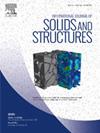Shock induced damage and failure mechanisms of magnesium aluminate spinel based on an atomistically calibrated bond-based peridynamic model
IF 3.4
3区 工程技术
Q1 MECHANICS
International Journal of Solids and Structures
Pub Date : 2025-03-05
DOI:10.1016/j.ijsolstr.2025.113316
引用次数: 0
Abstract
Understanding the dynamic mechanical properties and failure behavior of polycrystalline magnesium aluminate spinel MgAl2O4 is an important task for the development and design of transparent ceramic armor. However, the lack of the consideration of the microstructural characteristics in existing investigations leads to difficulties in accurately explaining the relationship between microcrack propagation and macroscopic damage evolution. To further explore the influence of the microstructure on the dynamic mechanical behavior of MgAl2O4 spinel, in this study, we propose a modified peridynamic (PD) model which take into account the fracture properties of grain boundaries and a compressive failure criterion with a residual post-failure bond strength. Fracture parameters of grain boundaries in PD model are extracted from molecular dynamics (MD) modeling. Meanwhile, planar impact experiments are performed to calibrate the PD simulations. In addition to the observed pullback signal indicating spall, the reload signal representing failure wave is also captured in experiments. The numerical predictions agree well with present experimental results, and provide new insight into the damage characteristics and failure mechanisms in both spall and failure wave events. With the increase of grain size, the ultimate spall strength decreases, while the failure wave velocity increases. Moreover, the velocity transition interval between the spall fracture and the failure wave is obtained, and the appearance of the third recompression phenomenon is interpreted.
求助全文
约1分钟内获得全文
求助全文
来源期刊
CiteScore
6.70
自引率
8.30%
发文量
405
审稿时长
70 days
期刊介绍:
The International Journal of Solids and Structures has as its objective the publication and dissemination of original research in Mechanics of Solids and Structures as a field of Applied Science and Engineering. It fosters thus the exchange of ideas among workers in different parts of the world and also among workers who emphasize different aspects of the foundations and applications of the field.
Standing as it does at the cross-roads of Materials Science, Life Sciences, Mathematics, Physics and Engineering Design, the Mechanics of Solids and Structures is experiencing considerable growth as a result of recent technological advances. The Journal, by providing an international medium of communication, is encouraging this growth and is encompassing all aspects of the field from the more classical problems of structural analysis to mechanics of solids continually interacting with other media and including fracture, flow, wave propagation, heat transfer, thermal effects in solids, optimum design methods, model analysis, structural topology and numerical techniques. Interest extends to both inorganic and organic solids and structures.

 求助内容:
求助内容: 应助结果提醒方式:
应助结果提醒方式:


